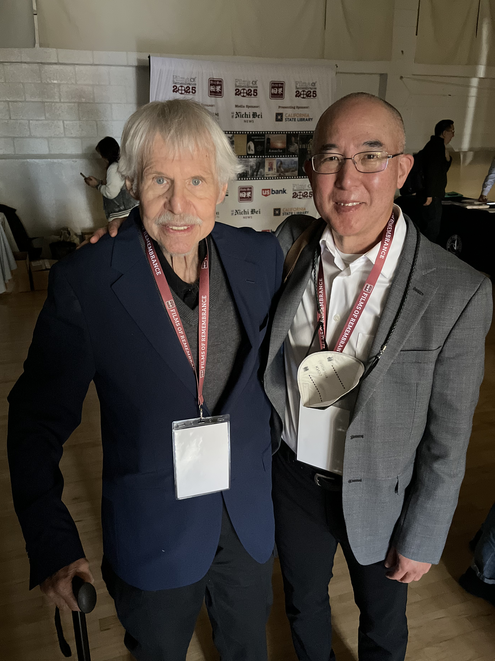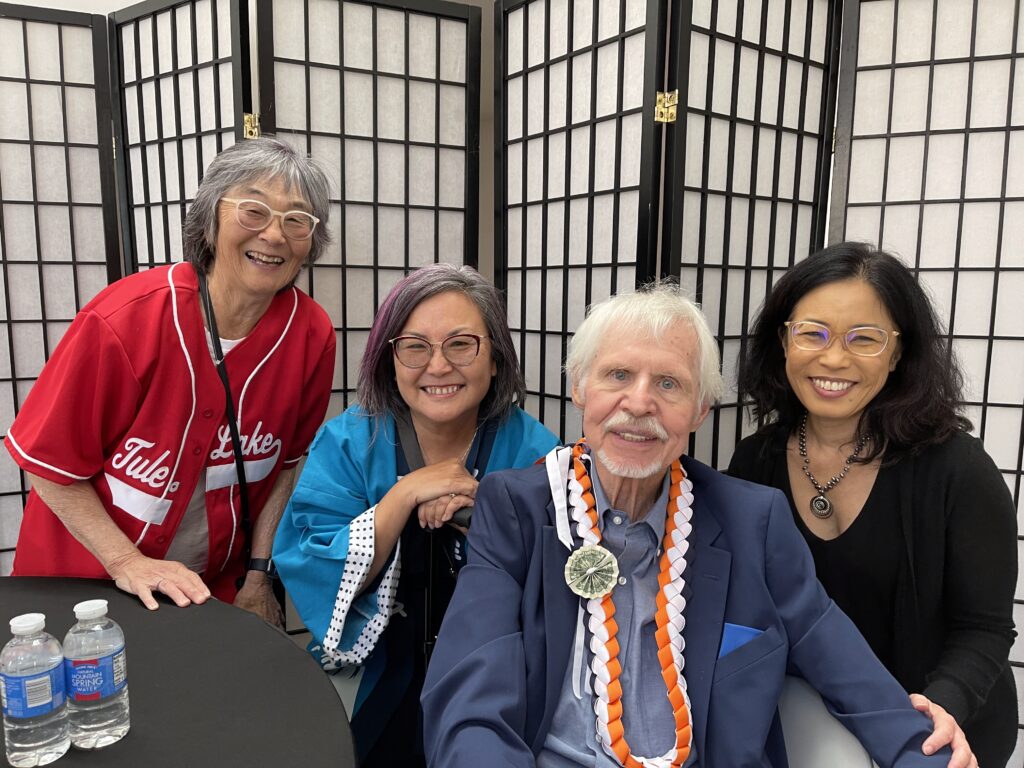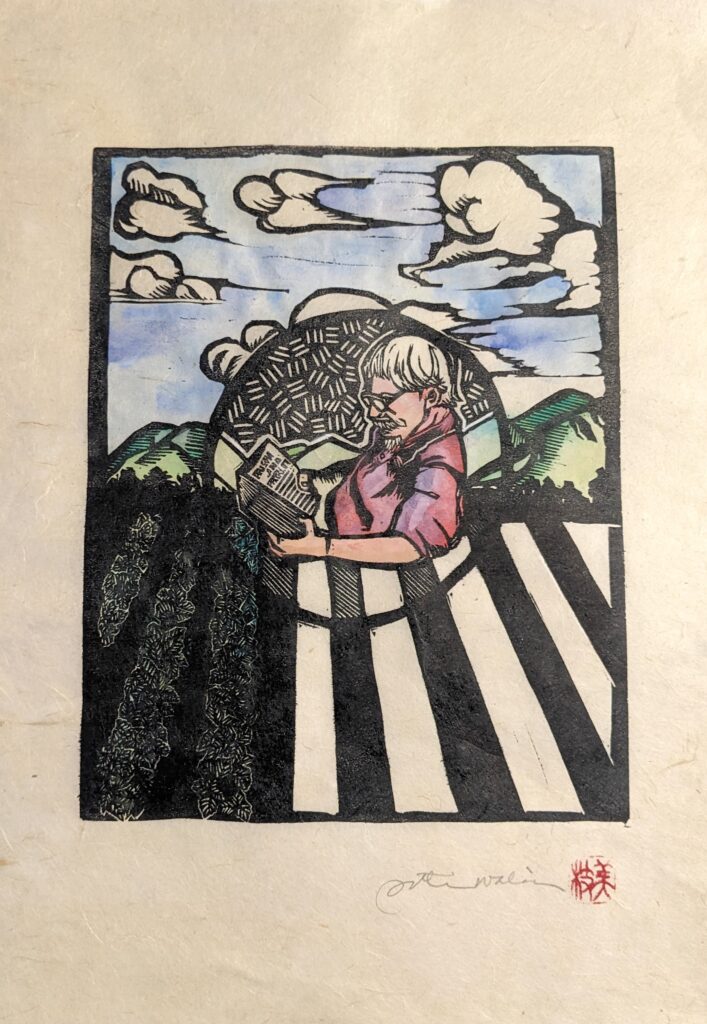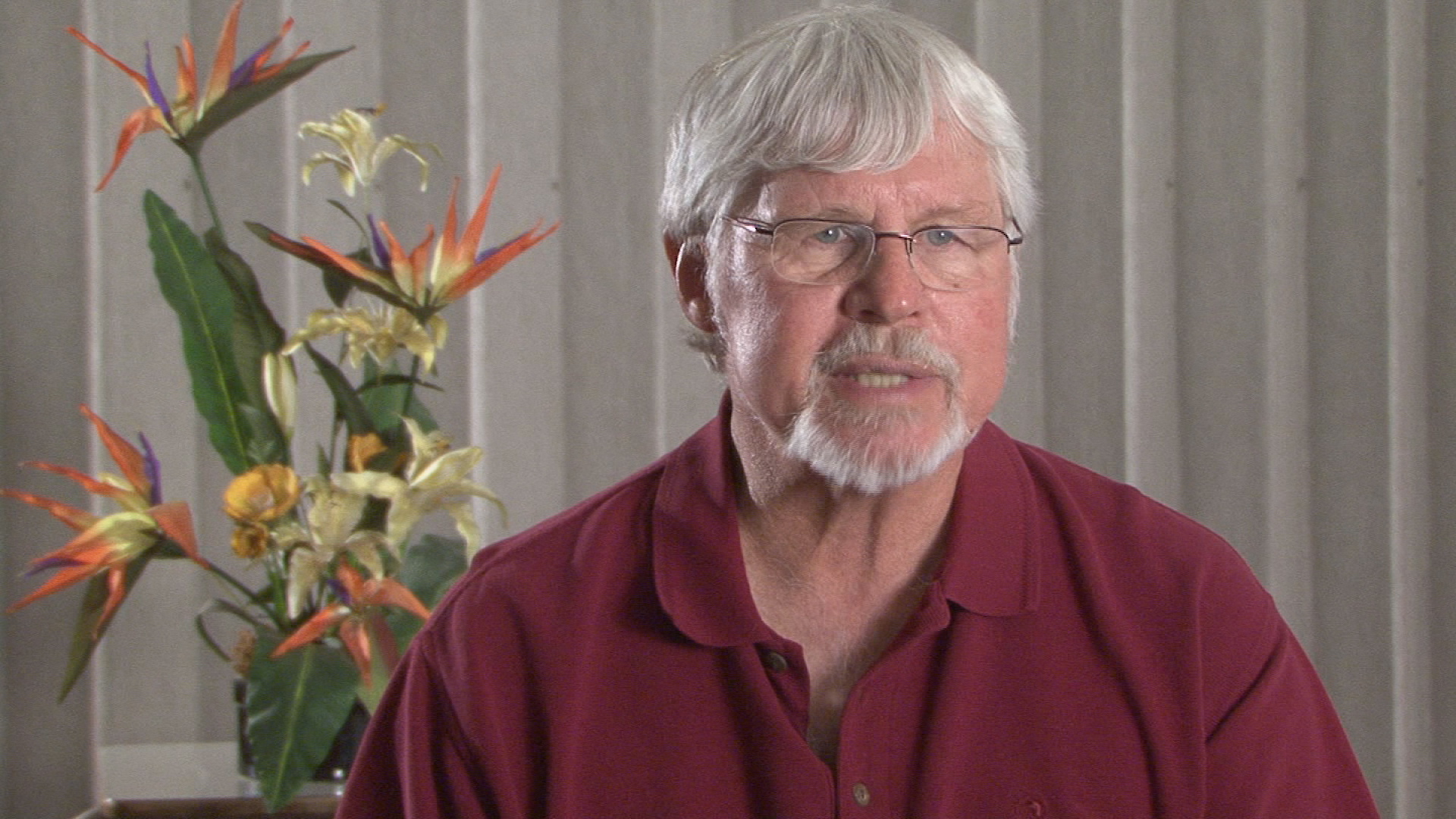November 11, 2025
Art Hansen was a devoted scholar and beloved community historian whose commitment to documenting Japanese American experiences and voices reshaped the WWII incarceration narrative and inspired generations of researchers and storytellers. In this collective tribute, Densho Content Director Brian Niiya and a cohort of Densho partners and collaborators—all of whom, along with Art himself, have written for Densho’s Encyclopedia—describe Art’s incredible contributions to and impact on the Japanese American community.

For over fifty years, Art Hansen has been one of the leading scholars of Japanese American history in general and of the World War II exclusion and incarceration in particular. When he came along in the early 70s, he was part of a new generation of scholars that came out of the movement for ethnic studies of that time and who challenged the then dominant narrative of Japanese American history, that of the so-called “quiet Americans” who compliantly went to “relocation centers” during World War II, emerging to become “model minorities” in the postwar world.
Art is among the group of scholars who has turned that narrative on its head, so that today, we as a community recognize that there were many responses by Japanese Americans to the roundup and incarceration, including significant resistance. Chronicling the story of that resistance has made up a large part of Art’s scholarship, whether writing about the unrest at Manzanar and Gila River, draft resistance, or many other topics. He has done so while working closely with the Japanese American community, whether with organizations like the Manzanar Committee or Japanese American National Museum or with individual families. His close connection to two such families and his editorial guidance has resulted in the recent publication of two memoirs by key Nikkei dissidents James Omura and Yosh Kuromiya.
He has also played a key role in promoting the work of others, myself included, in both academic journals and in public facing publications such as the Nichi Bei Weekly, for which he has been reviewing books for years. Densho is among the organizations he contributed to, authoring articles for the Densho Encyclopedia and sitting for two invaluable oral histories that are a part of our digital repository. (A third earlier interview he did with Frank Abe for the film Conscience and the Constitution is also in the DDR.)

But in addition to all of that, he also leaves behind an invaluable legacy in oral history. Soon after his faculty appointment at Cal State Fullerton, he began teaching about the wartime incarceration due in part to the influence of a colleague who would become a close friend, Kinji Yada. But in addition to his teaching and research, he started a Japanese American oral history program at Fullerton in 1973, with the first interview being with Sue Kunitomi Embrey, the founder of the Manzanar Committee.
Over the years, Art and his fellow interviewers have interviewed hundreds of people. This archive—much of which is now available through Densho’s website as part of the CSU Japanese American History Digitization Project—is an amazing resource that will fuel scholarship for years to come. I don’t know how many times I’ve wanted to do research on someone—whether a former inmate, a WRA administrator, or a fieldworker who studied the incarceration—to find that Art had interviewed that person decades ago. Through these oral histories, he has so much to teach us still.
A beloved colleague and mentor to many, Art was unstintingly generous and unfailingly uplifting in his interactions with colleagues. I chuckle when recalling the dozens of book reviews he did for the Nichi Bei—recently collected and published as A Nikkei Harvest: Reviewing the Japanese American Historical Experience and Its Legacy—which though always informative, are almost all positive, as if he didn’t want to discourage anyone from reading any well-intended work, even if flawed. I’ve also been inspired by Art’s run of publications since he retired from his faculty job. We’re fortunate that he was able to complete and publish a variety of works he had been working on over the years, though inevitably there were a couple that remain incomplete.
Though I am saddened by his passing, I can’t help but smile when I think of his friendliness, generosity, and inspired commitment to Japanese American history and community. He was truly one of a kind.
— Brian Niiya, Densho Content Director
Remarks and Reflections From Densho Collaborators
“Art Hansen’s unflinching kinship to Japanese American scholarship came from a love of both people and issues close to his heart. He often spoke of his astonishment at being accepted by a community with which he might be considered an outsider, but mutual respect grew as his work became one with the relationships he nurtured. His brilliant body of work was only surpassed by the many dear friendships he gained as a kind, generous, and steadfast ambassador. There will never be another like him.” — Sharon Yamato
“My understanding of Japanese American wartime resistance owes a debt to Art Hansen. I first encountered his vast knowledge and skillful interviewing in his 5-volume Japanese American Oral History Project. He shared information and networks cultivated over a lifetime to help others like myself connect to draft resisters, notably Yosh Kuromiya and Frank Emi, and enabled research on organizations like the Nisei Progressives.
When I think of Art Hansen, I think of many things—a brilliant, broad, and curious mind; a beautiful and engaging writer; and an ardent reader and scholar. I am grateful to have experienced Art’s generosity and mentorship.” — Diane Fujino
“Art’s interviews and writings informed me on the humanity and complexity of Japanese Americans in confinement—whether it be the plight of Manzanar mess hall worker Harry Ueno, at the center of the Manzanar Riot, former Rafu Shimpo editor Togo Tanaka, or the REgenerations subjects interviewed by Mary Doi, a Chicago-based volunteer trained by Art.
Through Art’s inspiration and creation of various projects and imprints, I was able to be involved in LIFE AFTER MANZANAR with Heather Lindquist, instrumental in the interpretive content at Manzanar National Historic Site, and SILENT SCARS OF HEALING HANDS, based primarily on oral histories of Japanese American camp medical professionals conducted by Art’s mentee, Gwenn Jensen.
Art’s interviews with Japanese Americans incarcerated in World War II camps are absolutely invaluable and will continue to be available for future generations seeking to piece together what effects governmental detention had on a group of people in the US. Without Art Hansen and his mentorship of other oral historians, those stories would have been gone forever.
His own humanity leaves behind countless people—friendships forged through the pursuit of investigating the Japanese American incarceration—mourning the loss of not being able to experience his intellectual vitality which was present even until the last weeks of his life.” — Naomi Hirahara

“Art Hansen was a skilled oral historian, who changed the practice of Japanese American history through his masterful collection of historical voices. He not only interviewed former inmates at length about their experience in camp, but interviewed camp employees, government officials, and neighbors, compiling a record of primary sources. People as far across the ideological spectrum as Harry Ueno, Charles Kikuchi, James Omura, and Togo Tanaka all appreciated Art’s knowledge and sincerity and entrusted him with their friendship and stories—even Lillian Baker, the notorious opponent of Japanese American redress, was taken with him.
Yet even more than his intellectual output and technical skill, his biggest impact on me was undoubtedly the man himself, as a model of an engaged scholar, and a generous human being.” — Greg Robinson
“To me, Art set a model for what historians should be: scholars who produce groundbreaking, detailed work while remaining in touch with the communities they served. Art worked tirelessly to document the stories of Japanese Americans through oral histories. Anyone interested in history of Japanese Americans will be indebted to the tireless work Art invested in preserving community history and uplifting the voices of Resisters.
Art will forever remain special not only as someone who inspired me to be a better historian, but also as a compassionate individual who brought out the best in others.” — Jonathan van Harmelen

“I first met Arthur Hansen, Senior Historian at the Japanese American National Museum in Los Angeles, around a table in the curator’s offices, with professor of Asian American studies, Lloyd Inui, art historian Karin Higa, and several staff members from the Collections Department. We met regularly to discuss acquisitions and donations to the Museum’s collections, each artifact a chance for rich debate and discussion. Whether we were wondering about the provenance of a family photo album or weighing the inherent storytelling value of a set of dolls created in Occupied Japan, every object lit up Art’s mind and conjured memories and stories.
As a pre-eminent oral historian and tireless researcher, writer, and lecturer, Art mentored and encouraged so many members of the JANM staff, encouraging them to find their niches in the community and to amplify their visions for the Museum. He also fattened us up, never failing to bring a box of strawberry donuts and tigertails from Jim Nakano’s Donut Man shop in Glendora.
I will never forget the time that poet Lawson Inada was invited to JANM for the launch of Art’s book, Beyond the Betrayal in 2022, and in homage to his greatness, pitched the idea of including Art Hansen in a Mt. Rushmore of JANM heads to be carved and installed above the pavillion. That just about killed me.” – Patricia Wakida
“As much as Professor Hansen is admired and respected for his work in academia, many in the Nikkei community will always remember him for his generosity and encouragement. He was an intellectual giant who used his influence to uplift others around him. Our hearts are heavy today, but the world is better because Art Hansen was more than an academic. He was one of us. Rest in Power, Professor Hansen.” — Glen Kitayama (from “Remembering Professor Art Hansen”, Manzanar Committee, Nov 5, 2025)
Art Hansen was unique for his curiosity and patience. He was a typical academic in a sense—he was securely embedded in a university department and contributed to its administration. But he also had a unique curiosity about the unknown, the forgotten, even the despised, and sought these people out, gained their trust, and captured their stories. Starting at Fullerton but extending beyond to other archives, museums, and generations of scholars of all kinds, Art’s sensibilities about history and what should be remembered, and the importance of making personal relationships in order to record histories, transformed how history was studied. Without Art, would we know so much less about the resisters, Jimmie Omura, the No-Nos, the sociologists in camps, and more. He was also a dear friend who always had time to sit down for a donut and coffee to find out what you were working on, what was going on in your life, and share some gossip. — Emily Anderson
Watch Art Hansen’s Oral History
Densho was fortunate to conduct two oral history interviews with Art Hansen and to preserve another interview with Art conducted by Frank Abe for his 2000 documentary Conscience and the Constitution. You can watch Art’s oral history interviews on our Densho Digital Repository.

Art Hansen’s Works on Japanese Americans
and David A. Hacker. “The Manzanar Riot: An Ethnic Perspective.” Amerasia Journal 2.2 (1974): 112-57.
“Cultural Politics in the Gila River Relocation Center, 1942-1943.” Arizona and the West 27 (Winter 1985): 327-62.
and Betty E. Mitson, and Sue Kunitomi Embrey. “Manzanar Dissident Harry Ueno Remembers.” California History 14.1 (Winter 1985): 58-64.
and Sue Kunitomi Embrey, and Betty Kuhlberg Mitson. Manzanar Martyr: An Interview with Harry Y. Ueno. Fullerton: Oral History Program, California State University, Fullerton, 1986.
“James Matsumoto Omura: An Interview.” Amerasia Journal 13.2 (1986-87): 99-113.
“Representations of an Imprisoned Poston Past.” Journal of Orange County Studies 3-4 (1989-1990): 102-08.
“Oral History and the Japanese American Evacuation.” Journal of American History 82.2 (Sept 1995): 625-39.
“The 1944 Nisei Draft at Heart Mountain, Wyoming: Its Relationship to the Historical Representation of the World War II Japanese American Evacuation.” OAH Magazine of History 10.4 (Summer 1996): 48–60.
“Sergeant Ben Kuroki’s Perilous ‘Home Mission’: Contested Loyalty and Patriotism in the Japanese American Detention Center.” In Remembering Heart Mountain: Essays on Japanese American Internment in Wyoming. Ed. and contribution by Mike Mackey. Powell, Wyoming: Western History Publications, 1998. 153-75.
“The Evacuation and Resettlement Study at the Gila River Relocation Center, 1942–1944.” Journal of the West 38.2 (April 1999): 45–55.
“Political Ideology and Participant Observation: Nisei Social Scientists in the Evacuation and Resettlement Study, 1942–1945.” In Guilt By Association: Essays on Japanese Settlement, Internment, and Relocation in the Rocky Mountain West. Edited and contributions by Mike Mackey. Powell, Wyoming: Western History Publications, 2001. 119–44.
“Return to the Wars: Jimmie Omura’s 1947 Campaign against the Japanese American Citizens League.” In Remapping Asian American History, ed. Sucheng Chan. Walnut Creek, CA: Altamira Press, 2003. 127–50.
“Peculiar Odyssey: Newsman Jimmie Omura’s Removal from and Regeneration within Nikkei Society, History, and Memory.” In Nikkei in the Pacific Northwest: Japanese Americans and Japanese Canadians in the Twentieth Century. Edited by Louis Fiset and Gail M. Nomura. Seattle: University of Washington Press, 2005. 278–307.
Barbed Voices: Oral History, Resistance, and the World War II Japanese American Social Disaster. Foreword by Lane Ryo Hirabayashi. Boulder: University Press of Colorado, 2018.
Manzanar Mosaic: Essays and Oral Histories on America’s First World War II Japanese American Concentration Camp. Foreword by Bruce Embrey. Boulder: University of Colorado Press, 2023.
with Wayne H. Maeda. A Nikkei Harvest: Reviewing the Japanese American Historical Experience and Its Legacy. San Francisco: Nichi Bei Foundation, 2024.
Edited works
and Betty E. Mitson. Voices Long Silent: An Oral Inquiry into the Japanese American Evacuation. Fullerton: Oral History Program, California State University, Fullerton, 1974.
and Gary Y. Okihiro, Shirley Hune, and John M. Liu. Reflections on Shattered Windows: Promises and Prospects for Asian American Studies. Pullman: Washington State University Press, 1988. [Papers from the 1987 annual meeting of the Association for Asian American Studies held in San Francisco.]
Nakagawa, George. Seki-Nin (Duty Bound). Fullerton: California State University, Fullerton, Oral History Program, 1989.
—
By Densho Content Director Brian Niiya, featuring tributes from Sharon Yamato, Diane Fujino, Naomi Hirahara, Greg Robinson, Jonathan van Harmelen, Patricia Wakida, Glen Kitayama, and Emily Anderson.
[Header photo: Portrait of Art Hansen. Photo taken during Densho oral history interview, December 6, 2010.]